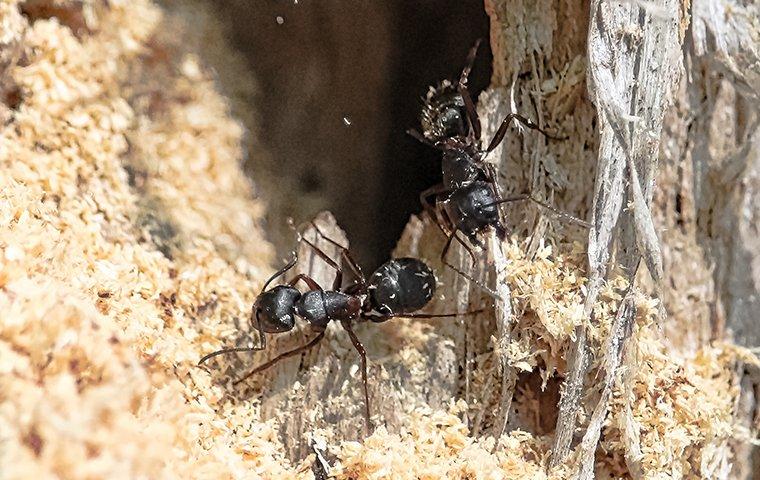Carpenter Ants Or Termites; Which Is Chewing Up My South Bend Home?
The only way to stop destructive pests in South Bend from doing irreversible damage is by identifying their populations quickly and taking the proper steps to eliminate them. The best way is with help from the pros, but here’s some crucial information to get you started on true pest protection.

Ants vs. Termites
Two common and invasive pests in South Bend create significant property damage thanks to their wood-boring ways: termites and carpenter ants. Both form elaborate colonies that allow them to divide and conquer, forming outdoors and then growing towards human structures. Both insects also begin their colonies through the actions of their swarming reproductive members. These alates, the only winged members of their populations, can be difficult to tell apart, but there are some key differences between termite colonies and carpenter ant colonies.
Termites
- Appearance: It’s important to note that, other than the flying swarmers, you’re not likely to actually see a termite. They spend their entire lives underground, so physical differences aren’t usually a factor when it comes to identifying these pest problems.
- Habitat: Termites are blind, so their eyes shy away from sensitive light. As such, they stick to their soil tunnels and tend to even stop chewing through the wood before punching through to the surface.
- Diet: Termites eat wood and other things that contain fibrous cellulose. They often start by targeting exterior vegetation like bushes, trees, and woodpiles, and then find ways to target structural woods.
Ants
- Appearance: Carpenter ants tunnel through wood and soil, too, but they crawl around out in the open like other ants, too. That sets them apart from termites, but they look an awful lot like other common house ants, so you’ll need to look for other signs, too.
- Habitat: Carpenter ants tend to target moist, decaying woods. That includes outdoor targets like stumps and bark mulch, but also structures like sheds and homes.
- Diet: Unlike termites, carpenter ants don’t eat the wood they chew through. Instead, they use wood to make tunnels for protective storage. Instead, carpenter ants are attracted by many of the same things as other foraging ants, particularly sugary aromas.
What Attracts Them
No matter which wood-damaging pest is a concern, they are attracted by similar things. All pests invade because of the easy access to food and shelter that they can find on human properties. As such, it’s important to address these factors:
- Wood storage: Naturally, properties with woodpiles or other yard debris make for prime targets for both termites and carpenter ants.
- Soil contact: Anywhere that soil touches your exterior is a potential access point for these pests. While it can be impossible to completely address subterranean access, you can help your cause by being mindful of where your flower beds are.
- Moisture control: Both kinds of pests are attracted to moist areas and like to target waterlogged wood. Be sure to address leaky pipes quickly and regularly inspect for water damage.
Different Kinds Of Damage
It can be hard to spot pests directly and, unfortunately, the damage is often the first and only sign property owners get that a pest infestation is active. That’s why it’s important to call experts quickly, to nip populations in the bud before they can cause larger structural harm. But it’s also important to take note of the kinds of damage, which can signal pervasive destruction by termites or carpenter ants.
- Speed: Termites don’t sleep, meaning they can stay up 24 hours a day boring through woods. If you notice that damage is accelerating quickly, it’s likely termites.
- Holes: If you’re seeing holes on surface woods, it’s probably carpenter ants, since they are far more likely to crawl on top of surface woods and bore directly in.
- Warping: All wood-boring pests can result in warping woods around your property. That’s because the surface tension of wood is altered by the hollowing out of its interior.
Act Fast With Professional Help
The most important takeaway is that neither of these pests is one that you want to try and handle on your own. Not only can they cause hazardous levels of damage in a short amount of time, but they can also survive DIY extermination attempts. Don’t waste money on methods that won’t work, instead, contact the experts at Termishield Termite & Pest Protection right away. Whether you need help identifying and removing existing populations or if you want our help with overall pest prevention, our friendly staff is here to help. today to get started on true protection for your property.
Tags: ants vs termites | ant prevention | termite damage |
Request Your Free Inspection
Complete the form below to schedule your no obligation inspection.

